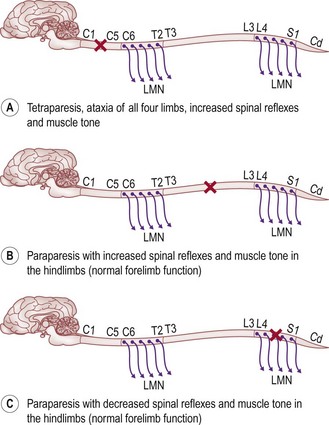37 Gait – an introduction
Weakness (paresis) or paralysis, ataxia, and lameness are the most commonly observed alterations in gait.
PARALYSIS AND PARESIS
DEFINITIONS
The animal is described as
• Non-ambulatory tetraparetic: weak in all four limbs. Able to move all limbs but unable to stand and walk unaided
• Monoplegic: weakness of one limb. Usually described by stating which limb is affected and how badly, e.g. paralysis of the right forelimb or weakness of the left hindlimb.
LOCALIZATION
• Damage to the connection between nerves and muscles, the neuromuscular junction, causes paresis/paralysis
But…if the tone and reflexes are reduced (1+) or absent (0) on examination it means that those reflex arcs do not work and somewhere in that reflex pathway is to be found the lesion causing weak or paralysed limbs (Fig. 37.1) (see p 20, Table 2.3).




